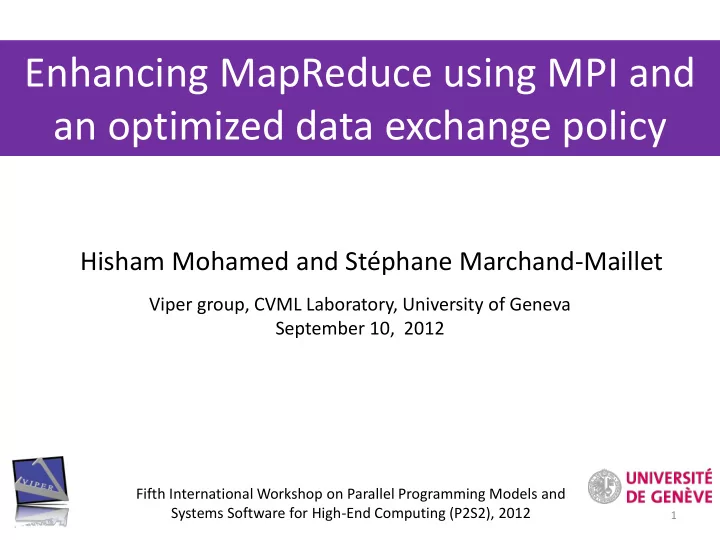

Enhancing MapReduce using MPI and an optimized data exchange policy Hisham Mohamed and Stéphane Marchand-Maillet Viper group, CVML Laboratory, University of Geneva September 10, 2012 Fifth International Workshop on Parallel Programming Models and Systems Software for High-End Computing (P2S2), 2012 1
Outline • Motivation • MapReduce • MapReduce overlapping using MPI (MRO-MPI) • Experiments – Wordcount – Distributed inverted files. • Conclusion 2
Motivation • Cross Modal Search Engine (CMSE) 3
Motivation • Scalability – Multimedia Data increases rapidly. • Indexing • Searching – High dimensional data. 4
Our proposed solution • In CMSE, we need data and algorithm parallelization. • MapReduce overlapping using MPI (MRO-MPI) – C/C++ implementation of MapReduce using MPI. – Improving the MapReduce Model. – Maintain the usability of the Model. 5
Outline • Motivation • MapReduce • MapReduce overlapping using MPI (MRO-MPI) • Experiments – Wordcount – Distributed inverted files. • Conclusion 6
MapReduce • MapReduce brings a simple and powerful interface for data parallelization, by keeping the user away from the communications and the exchange of data. 7
MapReduce • The current model for MapReduce has at least three bottlenecks: – Dependence. – Multiple Disk access. – All-to-All communication. 8
MapReduce Overlapping (MRO) • Send partial intermediate (Km, Vm) pairs to the responsible reducers. • We rule out: – The multiple read/write. – Shuffling phase is merged with the mapping phase. – Reducers do not wait until the mappers finish their work. • Difficulties: – Rate of sending data between Mappers and Reducers. – The ratio between the Mappers and Reducers 9
MapReduce Overlapping using MPI (MRO-MPI) • MapReduce – Data parallelization. • Message Passing Interface (MPI) – Separate processes with a unique rank . – MPI supports point-to-point, one-to-all, all-to-one and all-to-all communications. – Communication between processes. • MapReduce-MPI – Based on the original MapReduce Model 10
MRO-MPI Time 11
MRO-MPI Time 12
MRO-MPI Time 13
MRO-MPI Time 14
MRO-MPI – Rate of Sending the data Time 15
MRO-MPI Time 16
MRO-MPI Time 17
MRO-MPI – Same simple interface – Extra parameters: Time – Rate of sending data. – Number of Mappers to Reducers. – Data type. 18
Outline • Motivation • MapReduce • MapReduce overlapping using MPI (MRO-MPI) • Experiments – Wordcount – Distributed inverted files. • Conclusion 19
WordCount • WordCount: – Reads text files and counts how often words occur. – Input data size varies from 0.2Gb to 53Gb from project Gutenberg. 20
WordCount • MRO-MPI: 24 as mappers and 24 as reducers. • MR-MPI: 48 cores are used as mappers then as reducers. • Hadoop: 48 reducers and the number of mappers varies according to the number of partial input files. Speedup: 1.9x 5.3x X-axis: Data size in gigabytes. Y-axis: log 10 of the running time. Values in the table show the 21 running time in seconds. Values above the columns shows the size of each chuck.
Outline • Motivation • MapReduce • MapReduce overlapping using MPI (MRO-MPI) • Experiments – Wordcount – Distributed inverted files. • Conclusion 22
Inverted Files • Inverted Files is an indexing structure composed of two elements: the vocabulary and the posting lists. – Vocabulary – Posting lists Name= Doc1 #id=1 Vocabulary Posting Lists Computer security known as information security as applied to computers and networks......... apply <1,tf-idf>, Name= Doc1 #id=2 …. clash …. MapReduce has been used as a framework for Corpora distributing larger corpora........ <1,tf-idf> Compute Name= Doc1 #id=3 framework Protesters have been clashing with security forces. No <2,tf-idf> force information....... information …… <1,tf-idf>,<3,tf-idf> large …… MapReduce …. …… …. networks …. …… protest 23 <1,tf-idf>,<3,tf-idf> security
Inverted Files – tf-idf • tf-idf - weighting scheme (SMART system,1988): – Used to evaluate how important a word in a document with respect to other documents in the corpus. – Term Frequency (tf): • : number of occurrence of term in document . – Inverse Document Frequency (idf): : number of documents where appears. • • : total number of documents. 24
MRO-MPI for inverted files • Mappers: – (K m , V m ) = (term, (document name, tf)). • Reducers: T1 – Distributes the data based on their lexicographic order, each reducer being responsible for a certain range of words. – Similar terms are saved into the same database, reducer nodes can calculate the correct tf-idf value. 25
Distributed inverted files • 9,319,561 text (XML) excerpts related to 9,319,561 images from 12 million ImageNet corpus. • Data size: 36GB of XML data. • Hadoop: 40 minutes with 26 Reducers. • Double speedup because of sending the data while the map functions is working. • The best ratio between the mappers and reducers is found to be: 26
Conclusion • We proposed MRO-MPI for intensive data processing. • Maintain the simplicity of MapReduce. • High speedup with the same number of nodes. 27
Questions ? 28
Recommend
More recommend